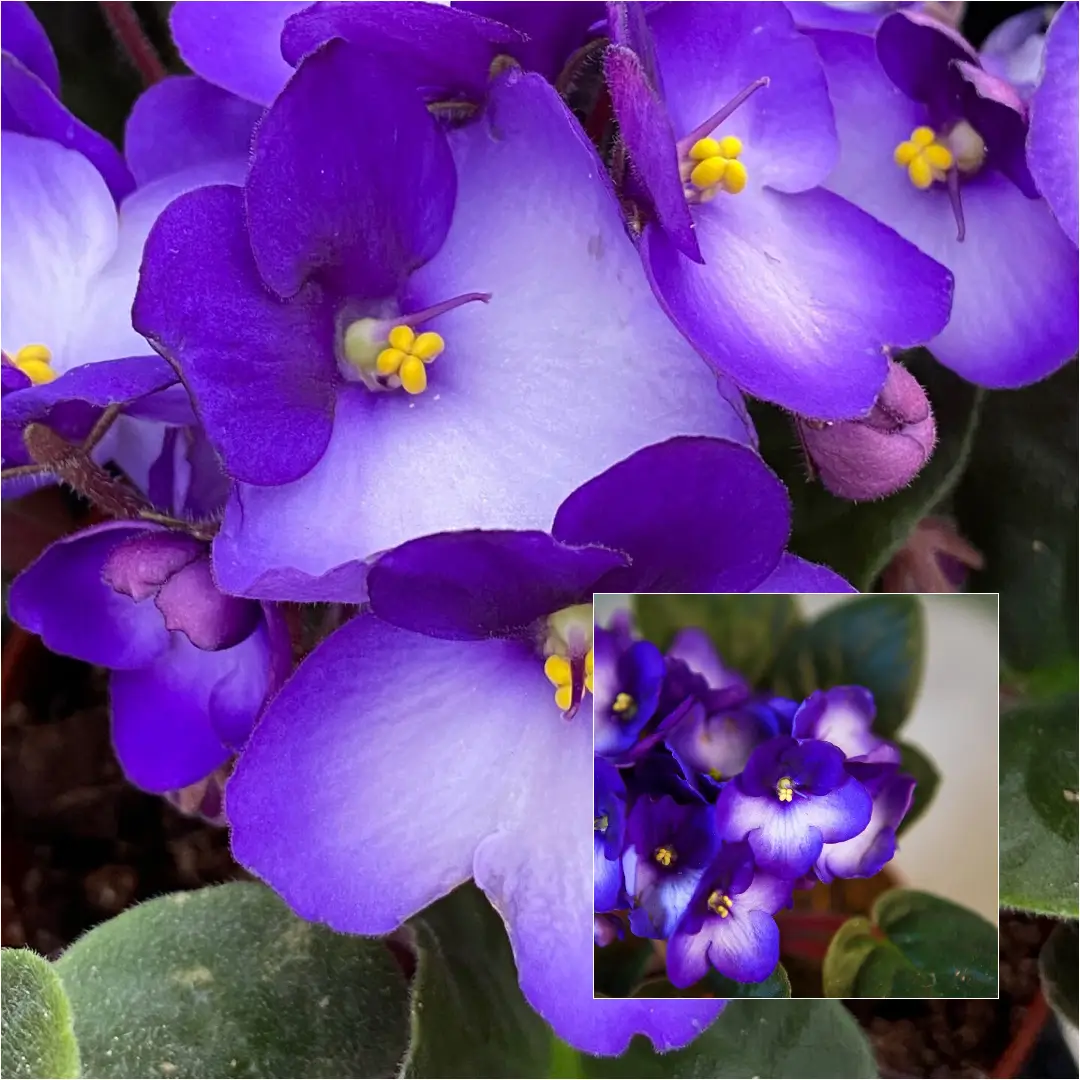African violets are more than just pretty flowers; learning how to care for African violets can be a delightful way to brighten up any room in your home. With their vibrant colors and lush, fuzzy leaves, these perennial beauties can bring joy throughout the year. But let’s face it: care for African violets can be a bit tricky if you don’t know what you’re doing. No worries, though! In this comprehensive guide, I’ll share everything you need to know about how to care for African violets, ensuring they thrive and bloom beautifully.
Understanding African Violets
Before diving into the specifics of care, let’s get to know our green friends a bit better.
What Are African Violets?
- Common Name: African violet
- Botanical Name: Saintpaulia ionantha
- Family: Gesneriaceae
- Plant Type: Perennial
- Mature Size: 6-9 inches tall and wide
- Sun Exposure: Partial sunlight
- Soil Type: Well-drained but moist
- Soil pH: Acidic to neutral
- Bloom Time: Spring, summer, fall, and winter
- Flower Colors: White, pink, red, blue, purple
- Hardiness Zones: 11-12 (USDA)
- Native Areas: Africa
Why Are African Violets So Popular?
One reason why many people love these plants is their ability to bloom multiple times a year, filling your space with color and life. Plus, they come in a variety of shapes, sizes, and colors, allowing you to express your personal style. Now, let’s explore how to care for African violets, so you can enjoy their beauty to the fullest.
Basic Care Tips for African Violets
Caring for African violets is all about creating the right environment for them to flourish. Let’s break down the essentials step by step.
1. Light Requirements
Care for African violets includes ensuring they thrive in bright, indirect sunlight. Here are some tips to ensure your plants get the right amount of light:
- Indirect Sunlight: Position your African violets near a window where they can receive bright light without direct sun exposure. Too much direct sunlight can scorch their delicate leaves.
- Fluorescent Lights: If natural light is limited, consider using fluorescent lights. Place them about 12 to 15 inches above the plants. This setup mimics the natural environment they love.
- Signs of Light Imbalance:
- Too Much Light: If you notice light green leaves, your plant might be getting too much sun.
- Too Little Light: Thin, dark green leaves or a leggy plant indicates your African violet needs more light.
2. Soil Type
Choosing the right soil is crucial when you learn how to care for African violets.
- Well-Drained Potting Mix: Use a special African violet potting mix or a well-drained general potting soil. Poor drainage can lead to root rot, a common problem for these plants.
- Avoid Standing Water: Make sure your pot has drainage holes and never let your plant sit in standing water.
3. Watering Practices
Watering is one of the most important aspects of how to care for African violets. Here’s how to do it right:
- Moist, Not Wet: Keep the soil moist but not soggy. Use warm water and aim for high humidity.
- Watering Method: To avoid water on the leaves (which can cause spots), water from below. You can place the pot in a bowl of water and allow it to soak up moisture, or use a self-watering pot.
- Moisture Meter: Invest in a moisture meter to determine when it’s time to water. This will help you avoid over or under-watering.
4. Temperature and Humidity
Care for African violets requires providing them with a warm and humid environment.
- Ideal Temperature: Aim for around 70°F (21°C). Avoid letting the temperature drop below 60°F (15°C).
- Humidity Levels: These plants thrive in high humidity. You might consider using a small plant humidifier or placing a tray of water with pebbles under the pots to increase moisture levels around the plants.
5. Fertilizing Your African Violets
Feeding your plants properly is another key aspect of how to care for African violets.
- Fertilizer Choice: Use a fertilizer formulated specifically for African violets. These are designed to provide the right nutrients.
- Feeding Schedule: Fertilize every other week during the spring and summer months. Follow the product label for the correct dosage, as over-fertilization can harm your plants.
Additional Care Suggestions
Now that we’ve covered the basics, let’s look at some additional care tips to keep your African violets healthy and thriving.
Humidity Control
Consider using a small humidifier or placing your plants in a naturally humid area of your home, like a bathroom or kitchen, to enhance the care for African violets. This extra humidity can help your African violets feel right at home.
Pruning and Maintenance
- Remove Dead Leaves and Blooms: Regularly check your African violets for any dead leaves or spent blooms. Gently remove these to promote new growth and healthier plants.
- Deadheading: When blooms fade, deadhead them to encourage more flowering. You’ll be amazed at how quickly new buds can form!
Propagation of African Violets
Want to multiply your collection? African violets can easily be propagated from leaf cuttings. Here’s how:
- Select a Healthy Leaf: Choose a healthy green leaf from the bottom of the plant.
- Make a Clean Cut: Using scissors, snip it off at the base of the plant. Cut the leaf stem at a 45-degree angle to about 1/2 inch in length.
- Potting the Cutting: Place the cutting into a small pot filled with a mixture of vermiculite and peat, and water it lightly.
- Create a Humid Environment: Cover the pot with a plastic baggie and place it in bright, indirect light.
- Watch for Growth: In about 12 weeks, you should see new baby plants emerging!
Potting and Repotting African Violets
Knowing when and how to repot is essential for healthy growth.
- Under-Potted Preference: African violets prefer to be slightly under-potted. This helps them stay healthy and encourages blooming.
- When to Repot: Only repot when necessary—typically when you notice falling leaves, overcrowding, or roots poking out of the soil surface.
- Repotting Technique: Gently lift the plant out of its current pot and place it into a larger container, using fresh potting mix. Be careful not to cover the crown of the plant.
Common Problems and Solutions
Even with the best care, you might encounter a few challenges. Here are some common problems and how to address them.
Not Blooming? Here’s Why!
If your African violet isn’t producing flowers, it might be due to insufficient light or incorrect temperature and humidity.
- Increase Light: Make sure it’s in bright, indirect light.
- Monitor Conditions: Ensure the temperature stays around 70°F and the humidity levels are adequate.
Spots on Leaves?
Spots often occur due to water resting on the leaves.
- Prevent Water Contact: Always water from the bottom or use a self-watering pot to keep water off the leaves.
Pests and Diseases
Even the hardiest plants can fall victim to pests and diseases. Here’s what to watch for:
Common Pests
- Spider Mites: These tiny pests can be a nuisance. You can treat them with neem oil or insecticide.
- Mealybugs and Cyclamen Mites: Also treatable with neem oil.
Diseases
- Root Rot: Avoid overwatering to prevent this common issue.
- Fungal Diseases: Fungi like botrytis blight and crown rot can be prevented by ensuring proper lighting, air circulation, and avoiding overwatering.
Encouraging Blooming
Want your African violets to bloom year-round? Here’s how to encourage those lovely flowers:
- Optimal Care: Provide the right light, water, humidity, fertilizer, and soil.
- Deadheading: Regularly remove spent blooms to encourage new ones. With proper care, you might see fresh flowers in about six weeks!
Caring for African violets can be a rewarding experience, bringing vibrant life and color into your home. By understanding their unique needs—light, water, soil, temperature, humidity, and nutrition—you can ensure these beautiful plants thrive. Remember, patience is key; with a little time and the right conditions, you’ll be rewarded with stunning blooms that can brighten any space.
So, whether you’re a seasoned plant parent or a curious newbie, I hope this guide helps you navigate the world of African violet care with confidence. Let’s get those blooms flourishing, and enjoy the colorful journey of gardening together!
FAQs
How often do you water African violets?
You should care for African violets by watering them when the top inch of the soil feels dry. Generally, this translates to watering every 1 to 2 weeks, but it can vary based on your home’s humidity and temperature. Always ensure the potting mix is moist but not soggy, and remember to water from below to prevent leaf spots.
How do you care for an African violet indoors?
To care for African violets indoors, place them in bright, indirect light, keep the soil consistently moist (but not wet), and maintain a temperature around 70°F (21°C). Additionally, provide high humidity, fertilize every other week during the growing season, and regularly prune dead leaves and spent blooms.
How do I keep my African violet happy?
To care for African violets and keep them happy, ensure they receive the right amount of light, maintain consistent moisture in the soil, and provide adequate humidity. Fertilize regularly and repot when necessary. Finally, monitor for pests and diseases, and deadhead spent blooms to encourage new growth.
Where is the best place to put an African violet?
The best place to care for African violets is near a window with bright, indirect sunlight. Avoid placing them in direct sunlight, which can scorch the leaves. Alternatively, you can use fluorescent lights positioned about 12 to 15 inches above the plant if natural light is limited.


